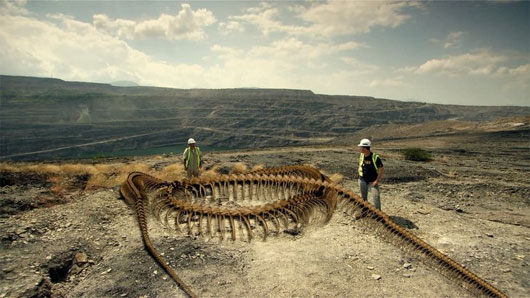It is about time for giant snakes
It is a warning by scientists from the new study: warming temperatures can shrink mammalian size and produce giant reptiles.
Tens of millions of years ago, snakes were as big as horses, and horses were nearly the size of snakes today. And in a warming world today, this situation can be repeated again.'Size of animals changes with climate' , NBC News quoted Jonathan Bloch, a paleontologist of Florida Museum of Natural History. To draw this conclusion, Bloch has attempted to deepen the relationship between body size and global temperature, especially in the hot period known as PETM , the period of prolonged maximum temperature. up to 100,000 years at the end of The Old Tan and early The Thuy Tan, 55 million years ago.
For many years, Bloch and his colleagues tracked the rise and fall of The Old Tan, which lasted from the extinction of dinosaurs 65 million years ago to the beginning of The Water Tan about 56 million years ago. One of the key sites for fossils at that time was the Cerrejon mine in Colombia, where active coal layers were so active that they could ignite themselves.'The place is really like hell, but it's a fossil's paradise , ' explained Bloch. It is also where he finds evidence of the existence of 60 million-year-old turtles, the size of a table, and the snake-like species of a bus.

Reconstruction of the Titanoboa skeleton - (Photo: Smithsonian Channel)
Snakes, turtles, and other reptiles tend to depend on the environment to regulate body temperature, so they are classified as cold-blooded. The only thing that makes the ancient cold-blooded species grow to such a terrifying extent is that they must live in a hot climate, and the world is really hot in the PETM period. Experts estimate that global temperatures must then increase from 5 to 8 degrees Celsius today, due to the mysterious and widespread greenhouse gas emissions. For example, Titanoboa snake must thrive at a temperature of about 34 degrees C.
At the same time, paleontologists have also studied how mammals have reacted in hot temperatures during the PETM period. Last year, Bloch and colleagues provided answers to this question. Accordingly, the ancestors of modern horses were reduced to the size of domestic cats to adapt to the above temperature. Recently, another group has published research results showing that each occurrence of a dwarf phase in mammals occurs during the second warming period about 2 million years later from PETM.
'The fact that the situation has been repeated twice has made us more certain about the causal relationship of global temperature, that the past warming situation has significantly reduced the size of mammals' , according to University of Michigan expert Philip Gingerich. Several reasons have been proposed to explain this dwarfism, such as when the temperature rises to 35 degrees Celsius for a long time, mammals have difficulty regulating body temperature, while the source Outside food is scarce. Therefore, reducing the size of the body helps them survive through a difficult period.
And the most frightening part is that if it ever happened in the past, the situation could replicate once conditions were met, which might be earlier than experts' predictions. Bloch said the CO2 content in the air is approaching the level of the PETM era. If you do not seek to adjust, the consequences will be unpredictable.
- Poisonous snakes in Vietnam
- Close-up of tiny animal snakes swallowed giant frogs
- Video: Stress 'great war' giant snake against tyrant dinosaurs
- The cold-blooded assassin has a poison 'see' at the same time 20 people return to the dead
- In fact, snakes often suffer from blindness in the summer
- Giant snake squash protects Phong Nha - Ke Bang forest
- Giant lizards block the battle lines with snakes
- The truth about 11 extremely poisonous snakes in the world
- Strange little known about snakes
- Marvel at the giant snake that spans 57 at a time
- 7 snakes look scary ... but harmless to humans
- Find a new snake, but no one can find it
 Animal 'suffering' after hibernation
Animal 'suffering' after hibernation Why do goats climb well?
Why do goats climb well? Scientists were surprised to see chimpanzees eating turtles
Scientists were surprised to see chimpanzees eating turtles Giant catfish died deadly due to drought in Thailand
Giant catfish died deadly due to drought in Thailand